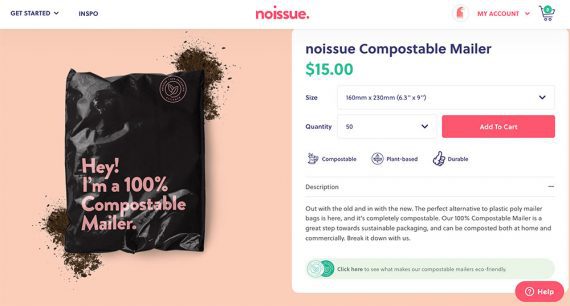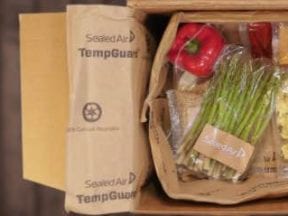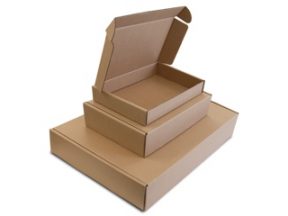Compostable, biodegradable mailers and boxes are among 2022’s top environmental fulfillment trends. Consumers and governments expect ecommerce businesses to help lower carbon emissions and move toward sustainability. Online sellers are responding. Many are changing their operations.
It is, however, important to understand packaging’s component materials since not everything recyclable or biodegradable is equally helpful.

Noissue is one of several packaging suppliers offering compostable ecommerce mailers. This example is made from two biodegradable materials: PLA and PBAT.
The Terms
Four terms play a role in environmental packing material.
- Recyclable. A material that can be broken down and reused, often of lower quality.
- Biodegradable. Material that will break down naturally without causing environmental harm.
- Compostable. Material that will break down naturally and provide nutrient-rich soil or humus.
- Sustainable. Material sourced from renewable or highly-efficient processes.
The Streams
Next, it is helpful to understand where ecommerce packaging tends to end up.
- Landfills. Engineered and managed solid waste facilities. Landfills in developed countries are typically well regulated and efficient. Local government agencies often operate landfills, but for-profit companies do it, too.
- Recycling operations. Manufacturing plants that rely on used materials as a resource. Some municipalities run recycling facilities. Private, for-profit companies often process materials for resale.
- Oceans and seas. Some waste is dumped offshore. Regulations and requirements differ among nations.
Some observers believe it is better to keep packing materials out of landfills. But biodegradable materials, for example, are less recyclable than traditional plastics and decompose naturally in a landfill.
Polymer Mailers; Cardboard Boxes
Polymer mailers and cardboard boxes are among the most common forms of ecommerce packaging.
Those materials are recyclable. Placing these plastics and cardboard in a proper recycling bin will likely result in new mailers, boxes, or similar.
However, a poly mailer or cardboard box degrades every time it is recycled — the fibers in cardboard become shorter. Thus a box cannot become quality paper, but cardboard from recycled paper is common and much more efficient than using virgin materials.
Recycling requires energy, chemicals, and water. Hence there’s a cost to the environment each time we recycle. Nonetheless, using recycled products is one way for ecommerce merchants to foster sustainability.
Some shoppers won’t recycle and will instead send discarded mailers and boxes to the landfill. While landfills are safe, some of these materials can take a few hundred years to break down.
Biodegradable Plastics
Relatively new biodegradable plastics are often touted as a better alternative to recyclable polymers for ecommerce mailers or even product packaging.
Microbes naturally break down biodegradable plastics over time, converting the material into water, carbon dioxide, and biomass.
There are at least three categories of biodegradable plastics: biodegradable petroleum-based plastics, biopolymers (often called bioplastics), and hybrid plastics that combine the two.
Polybutylene adipate terephthalate (PBAT), made from petroleum, is a biodegradable plastic used in some ecommerce mailers. PBAT is different from bioplastic. For example, some bioplastics are derived from bacteria during the manufacturing process.
Other bioplastics such as polylactic acid (PLA) result from fermentation using plants like corn or sugar beets. PLA is a popular bioplastic because it does not contribute to greenhouse gas emissions and is compostable.
Again, biodegradable material breaks down naturally and does not harm the environment, while compostable material produces humus that may be beneficial. Thus, all compostables are biodegradable, but not all biodegradables are compostable.
PLA then is perhaps a better option than a biopolymer that is only biodegradable.
Ecommerce companies that choose biodegradable plastic mailers may also want to understand the components. A PLA-based mailer will probably help reduce carbon emissions in some small way, while other materials derived from petrochemicals might not.
In short, ecommerce uses enormous volumes of packing and shipping material. Shifting those materials to eco-friendly alternatives requires an understanding of the underlying contents.




